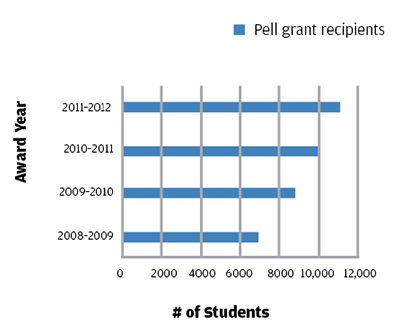Few things inspire more contentious debate than the topic of government responsibility for education. Some people hold that higher education is a privilege, while others believe it’s the responsibility of any government to provide the means of gaining knowledge to its citizens.
The right to education
Few things inspire more contentious debate than the topic of government responsibility for education. Some people hold that higher education is a privilege, while others believe it’s the responsibility of any government to provide the means of gaining knowledge to its citizens.
The Federal Pell Grant Program, established to aid those with serious financial need in paying for college, is one way the government chose to relieve the burden of funding education from
“vulnerable citizens.”
Eligibility for the program comes from the determination of a “low-income” status. Specifically, parents or recipients of a Pell grant should have an annual income rate of $50,000 or less per year, but most grants are “awarded to students with total family income which is equal to or less than $20,000,” according to the foundation’s website.

The College Board estimates that most four-year public universities average a yearly cost of attendance around $17,000. This makes attending college a significant burden for people without means, because the vast majority of their income would go to fund one expense, leaving little available for emergency costs or unexpected expenditures.
Some congressional members believe the way the program currently functions belittles its original intent. Claims of grant abuse have led some GOP politicians to call for cuts, dismissing Pell grants as wasteful welfare spending.
Additionally, critics argue that underprivileged students may discover that, even with government aid, they can’t keep up with the rising cost of tuition. This indicates a problem with Pell grants, because recipients may not commit to completing their education.
For program opponents, this is enough to eliminate the program altogether.
However, recognition of a problem within a program is not grounds for immediately dismantling the entire aid system. Instead, we should focus on the program’s intended goals and its ability to achieve them.
Economic downturn has led to increasing poverty levels, yet tuition rates at public universities are on the rise. As a result, more people than ever before qualify for need-based financial aid.
Pell grants are meant to level the playing field for students with little or no expected family contribution toward tuition costs. With a grant, the student isn’t unjustly burdened with the high cost of attending college and can focus on being a good student.
The program isn’t meant to offset the imbalance of tuition hikes run amok.
If politicians are serious about improving the function of our education system, they will focus on cutting tuition tax breaks for wealthy families. They’ll explore the Obama plan to reward colleges according to their ability to provide reduced tuition rates.
The Pell Grant Program’s condition is a clear indicator of America’s economic health, as well as a measure of our nation’s commitment to education. It allows us to gauge our ability as a nation to ensure no citizen falls prey to poverty.
If Pell grants were eliminated, lower-income college students would be less able to function at the same level as affluent students, giving unnecessary advantages to already privileged individuals. This only serves to perpetuate class-based distinctions among subgroups within the American population.
Unfortunately, opponents of the Pell program only see dollar signs.



